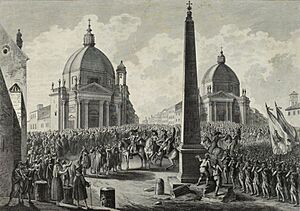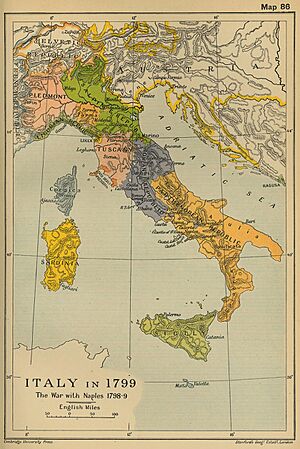Roman Republic (1798–1799) facts for kids
Quick facts for kids
Roman Republic
Repubblica Romana (Italian)
|
|||||||||||||
|---|---|---|---|---|---|---|---|---|---|---|---|---|---|
| 1798–1799 | |||||||||||||
|
Motto: Il popolo solo è sovrano
The people alone are sovereign
|
|||||||||||||

Departments of the Roman Republic in 1798
|
|||||||||||||
| Status | Sister republic of Revolutionary France | ||||||||||||
| Capital | Rome | ||||||||||||
| Common languages | Italian | ||||||||||||
| Government | Directorial republic | ||||||||||||
| Directory | |||||||||||||
|
• 1798–99
|
Roman Directory | ||||||||||||
| Legislature | Legislative Council | ||||||||||||
| Historical era | French Revolutionary Wars | ||||||||||||
|
• Republic declared
|
18 February 1798 | ||||||||||||
|
• Neapolitan invasion
|
30 September 1799 | ||||||||||||
| Currency | Roman scudo, Roman baiocco | ||||||||||||
|
|||||||||||||
| Today part of | Italy Vatican City |
||||||||||||
The Roman Republic (called Repubblica Romana in Italian) was a country that worked closely with the First French Republic. It was created on February 15, 1798. This happened after Louis-Alexandre Berthier, a French general, took control of the city of Rome on February 10.
This new republic was led by a group of five men called a Directory. It included land that used to belong to the Papal States. Pope Pius VI, the leader of the Papal States, was sent away to France. He passed away there in August 1799. The Roman Republic quickly took over two other small republics that had been formed from Papal lands: the Tiberina Republic and the Anconine Republic. However, the Roman Republic did not last long. Troops from the Kingdom of Naples invaded and brought back the Papal States in October 1799.
Contents
How Rome Became a Republic
French Invasion of Italy
The French general Napoleon Bonaparte led an invasion of Italy from 1796 to 1797. This made him a very important commander in the French Revolutionary Army. Many countries had joined together against France in something called the First Coalition. These included Austria, Great Britain, and several Italian states.
Napoleon wanted to fight these enemies in Northern Italy. He hoped to make the Austrians agree to peace talks. He also wanted to make his army in Italy stronger. The invasion of Italy was also a way to trick the enemy. The First Coalition expected the main French attack to happen somewhere else. Rome, which was part of the Papal States, was also against France.
Taking Control of Rome
In April 1796, Napoleon's army crossed the Alps mountains. They quickly defeated the army of Piedmont. After these victories, Napoleon focused on the Papal States to the south.
In February 1798, the French army invaded the Papal States. They were upset because a French general had been killed there in December 1797. After a successful invasion, the Papal States became a "sister republic" of France. This meant it was a country controlled by France. It was renamed the "Roman Republic."
General Louis-Alexandre Berthier, one of Napoleon's generals, became its leader. Pope Pius VI was captured and taken out of Rome on February 20, 1798. He was sent to France, where he later died.
The Republic's Short Life
The Roman Republic faced many problems from the inside. Not many people supported it. On November 29, 1798, an army from the Kingdom of Naples marched into Rome. The city was not well protected. However, the Neapolitan army simply left Rome and went back home.
Later, in 1798 and 1799, the French general Jacques MacDonald led his forces in several battles. These included the Battle of Ferentino and the Battle of Civita Castellana.
The Roman Republic did not last long. On September 30, 1799, the army of the Kingdom of Naples invaded again. This time, the Papal States were brought back. Pope Pius VII returned to power in June 1800.
The French army invaded the Papal States one more time in 1808. After that, the land was split between the First French Empire and the Napoleonic Kingdom of Italy. This lasted until the end of the Napoleonic Wars in 1815.
How the Roman Republic Was Governed
The way the Roman Republic was set up was very similar to the French government at the time. It was also inspired by the ancient Roman Republic.
The main leaders were five people called consuls. They were in charge of running the country. The laws were made by two groups of people. One group was called the Tribunate, with 60 members. The other was the Senate, with 30 members. These two groups together chose the consuls.
See also
- List of historic states of Italy
- Unification of Italy (when Italy became one country)





